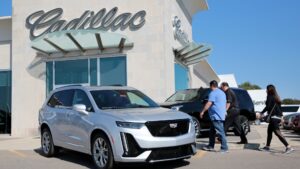General Motors Makes Strategic Shift: Ending Production of Cadillac XT6
In a significant development for the automotive industry, General Motors (GM) has announced the end of production for its gasoline-powered Cadillac XT6 crossover at its Spring Hill assembly plant in Tennessee. This decision reflects the automaker’s broader strategic pivot toward electric vehicles (EVs), aligning with its commitment to sustainability and innovation.
The Transition from XT6 to XT5
According to an internal memo confirmed by GM, production of the Cadillac XT6 will cease toward the end of this year, marking a notable shift in the brand’s lineup. However, fans of Cadillac can breathe a sigh of relief as the company will continue producing the smaller XT5 crossover until at least the end of 2026. This adjustment is based on "strong customer demand," a testament to the XT5’s popularity as Cadillac’s third-best-selling vehicle last year, following the Escalade SUV and the Lyriq EV.
A Bold Step Toward Electrification
This move is not simply a response to market pressures; it aligns with Cadillac’s commitment to transition towards a full lineup of electric vehicles. The internal memo clarified that these developments are not influenced by tariffs but are part of a strategic plan for the brand. Cadillac has moderated its previous ambitions to exclusively sell electric vehicles by 2030, reflecting the complexities of the current automotive market. In less than a year, the brand has introduced six new or updated products, showcasing a commitment to innovating both gas and electric segments.
The Cadillac Plant’s New Era
Spring Hill has been a pivotal site for GM, having produced the Cadillac Lyriq—the brand’s first electric vehicle—since its introduction in 2022. Additionally, the production of a new three-row crossover, the Vistiq, began recently at this facility, effectively replacing the XT6. This strategic development underscores GM’s focus on adapting to changing consumer preferences and advancing electric vehicle technology.
Sales Trends and Industry Insight
The decline of the XT6, which has averaged around 19,000 units sold per year since its launch in 2019, raises questions about consumer preferences in the crossover segment. It faced tough competition from the GMC Acadia, which shares many components and is priced more competitively. While sales figures haven’t met expectations, the shift to the Vistiq and the sustained production of the XT5 highlight GM’s agility in responding to market demands.
As part of the transition, there will also be scheduled downtime at the Spring Hill facility starting the week of May 12, along with temporary layoffs. This reflects GM’s approach to managing vehicle inventory in alignment with fluctuating demand—a crucial strategy in today’s volatile market.
Conclusion: The Future of Cadillac and GM
The landscape of the automotive industry is rapidly changing, and General Motors is making strategic adjustments that will shape its future performance. With a focus on electric vehicles and evolving consumer preferences, GM is positioning itself as a leader in innovation and sustainability.
At Extreme Investor Network, we will continue to monitor these developments closely, providing our readers with in-depth analysis and insights into how these strategic shifts will impact not only GM but the automotive market as a whole. Stay tuned for more updates as we delve deeper into the shifts in the automotive landscape, exploring how companies like GM are reinventing themselves in an era increasingly dominated by electric vehicles.

